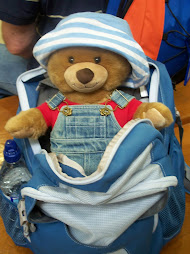It took us only an hour to get to the historical site in West Virginia. There we used the pass that Ms. Edwards purchased at Manassas. This pass will allow for us to get into any National Park any where in the country for the next year. It will also cover Ms. Wood. The pass will cover up to three people per visit.
Ms. Edwards and I spent about three hours walked around Harpers Ferry. There is a lot of history to this small area. I think that I will describe the history of the area by chronology.
Facts about Harpers Ferry:
- 1733 - Peter Stephens established the ferry at the lowest point of the two rivers
- 1747 - Robert Harper purchased the ferry and land.
- 1751 - Harper was given a patent for the present town
- 1761 - Harper started a ferry across the Potomac. The town was made a starting point for settlers going into the Shenandoah Valley.
- October 25, 1783 - Thomas Jefferson visited Harpers Ferry
- 1785 - George Washington visited Harpers Ferry. He was there to determine if there was a need for bypass canals. Some of Washington's family will settle in the area.
- 1796 - US Government purchased 125 acres and in 1799 started work on the United States Armory and Arsenal at Harpers Ferry.
- The armory produced muskets, rifles, and pistols.
- Captain John H. Hall pioneered the use of interchangeable parts in firmarms.
- 1833 - the Cheseapeake and Ohio Canal reached Harpers Ferry
- 1834 - The Baltimore and Ohio Railroad began train service through Harpers Ferry
- October 16, 1859 - John Brown led 22 men in a raid on the Arsenal. The first of his men killed was Heyward Shepherd a free black man. John Brown and his men were forced to take refuge in the engine house. Colonel Robert E. Lee was assigned commander along with Lt. J.E.B. Stuart as his aid-de-camp. The troops forced there way into the fire house and captured the raiders. Only one soldier lost his life.
- Brown was tried for treason in Charles Town. He was found guilty and was killed on December 2, 1859.
In the park there was an exhibit focusing on Lewis and Clark. It appears that Meriwether Lewis went to Harpers Ferry to pick up some of the supplies they would need on their trip. Below is a list of the supplies that he picked up.
40 fish gigs with a single barb point, 36 pipe tomahawks "for Indian presents", 24 pipe tomahawks, 24 large knives, 15 rifles, 15 powder horns and pouches, 15 pairs of bullet molds, 15 wipers or gun worms, 15 ball screws, 15 gun slings, 1 small grindstone, 1 collapsible iron farm boat, extra part of locks, and tools for repairing arms.
In all of my reading about the Lewis and Clark expedition I have never heard about Lewis's visit to Harpers Ferry.
Ms. Edwards and I were also interested in the men who joined with John Brown during his raid. Below is a lists of the men and what happened to them.
- John H. Kagi - killed at Harpers Ferry
- Jeremiah G. Anderson - killed at Harpers Ferry
- William Thompson - killed at Harpers Ferry
- Dauphin Thompson - killed at Harpers Ferry
- Oliver Brown (son) - Killed at Harpers Ferry
- Watson Brown (son) - Killed at Harpers Ferry
- Stewart Taylor - Killed at Harpers Ferry
- William Leeman - Killed at Harpers Ferry
- Lewis S. Leary - Killed at Harpers Ferry
- Dangerfield Newby - Killed at Harpers Ferry
- John E. Cook and Albert Hazlett - Escaped into Penn.
- Captured John Brown - Captured and imprisoned
- Aaron D. Stevens - Captured and imprisoned
- Edwin Coppoc - Captured and imprisoned
- John A. Copeland (Free African American) - Captured and imprisoned
- Owen Brown (son) - Escaped
- Charles P. Tiddy - Escaped
- Barclay Coppoc - Escaped
- Francis J. Merriam - Escaped
- Osborne P. Anderson (Free African American) - Escaped
The above information and more facts about the raid can be found at:
http://www.wvculture.org/History/jnobrown.html
help for this site came from:
http://www.nps.gov/hafe/
http://en.wikipedia.org/wiki/Harpers_Ferry
Okay...enough of the research...... Ms. Edwards and I want to share some pictures with you.
The first picture is of me sitting near a wagon on some boxes. I really gotta talk to Ms. Edwards about getting better pictures of me. You can hardly see me in the picture. Plus this was the only picture that she toook of me for the whole day.



Below is a picture of the outside and inside of John Brown's fort. Interestingly enough the fort had been moved several times.
1848 - Build as fire-engine house for US Army
1859 - Serves as stronghold for John Brown and his raiders
1861 - 1861 - Escapes destruction during Civil War (only armory building to do so), but is vandalized by souvenir-hunting Union and Confederate soldiers and later travelers.
1891 - Dismantled and transported to Chicago Exposition
1895 - Rescued from conversion to stable and brought back to Harpers Ferry area to be exhibited on a farm.
1909 - Purchased by Storer College and moved to campus.
1968 - Moved by National Park Service to within 150 feet of its original location.



One last picture that I would like to show is a picture of the waterway. There were a lot of people swimming in the water. Nearby there was a crosswalk that people could walk across. I was actually on a piece of the Appalachian trail.





No comments:
Post a Comment